Acrylic Painting Tips For Beginners: 5 Proven Steps To Master Your Skill
Despite being an amateur, you can make paintings like this…
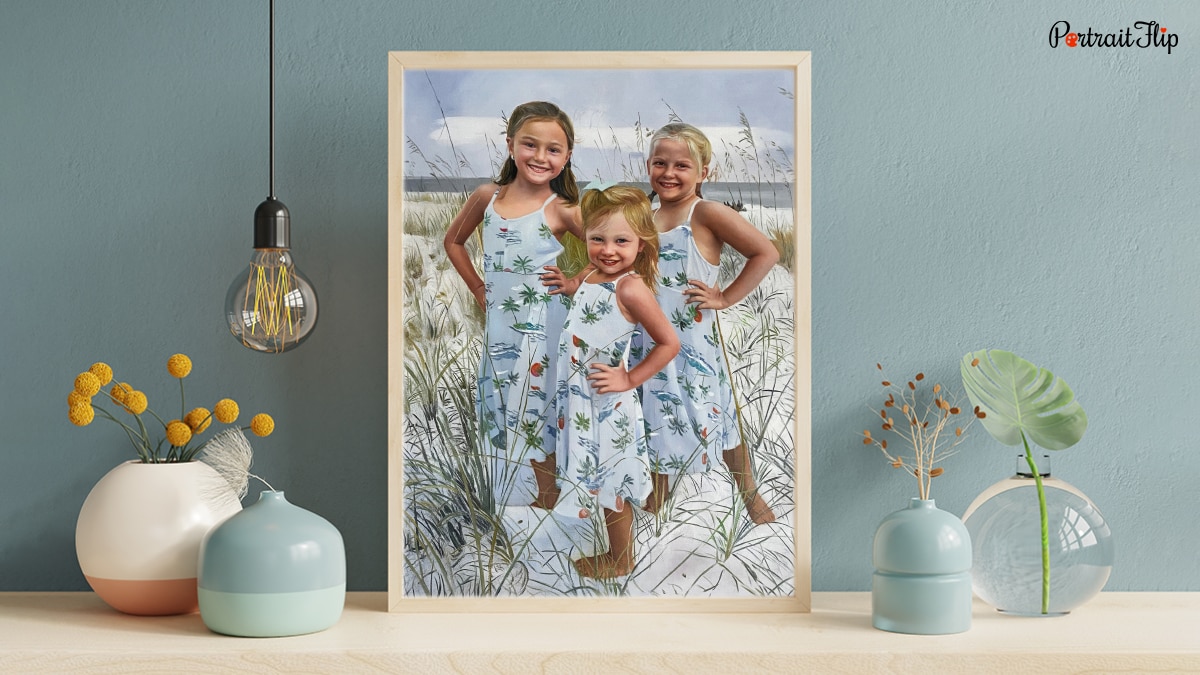
Also this.

…this too

However, you’ll require some tools, supplies, and importantly, the right technique through which you can make this happen.
This is why we’ve decided to write this blog to explain to you the nitty-gritty of acrylic paintings.
What you just saw were the finest creations of our artists.
And there are many more, since we’ve delivered hundreds of acrylic paintings across the globe.
Making art and becoming a master at it are two different things.
You can’t become Darien Bogart or produce the finest prints like Andy Warhol in a week or two. However, you can be a skilled acrylic painter if you constantly learn and improvise on your craft.
In order to help you learn new techniques and create art using acrylic paints, we decided to share some tried-and-tested acrylic painting tips.
(We also have a special discount on house acrylic portrait! If you would like to amp up your abode, look no further than this option)
Table of contents
A. What Do You Want To Paint With Acrylics?
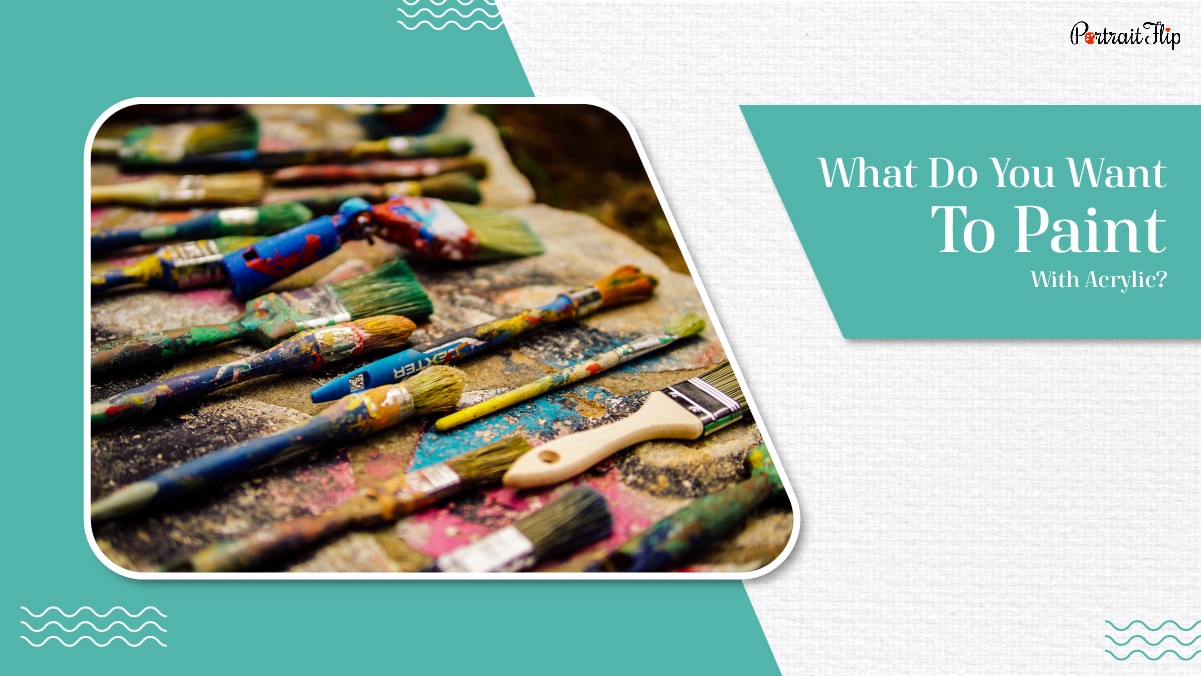
The most essential part of making paintings with acrylics is figuring out the subject or idea.
You can’t set up an easel, grab a canvas, and brush through it.
You’ve to picturise your subject before you take that brush up in your hand.
Here’s what you can do:
- Explore as much as you can until you find what really catches your eyes
- Try to view things from different angles to develop new perspectives.
- Observe what excites you and speaks to your soul
Throughout the process, you’ll understand what you want to paint with acrylic colors.
It can be a renowned landscape painting, an abstract art, an interior, or a wise owl.
Once you’ve decided on the subject, you will have to repeatedly view, study, and observe it until you get bored since it’s part of the creative process.
Tadaa! You’ve figured out the subject; you’re ready for the next step.
(suggested reads: Oil painting vs Acrylic painting.)
B. What Do You Need To Paint With Acrylics?

In this guide to acrylic painting tips for beginners, the three most important acrylic paint supplies you will require are acrylic paint, paint brushes, and a canvas.
You’ll need other supplies as well to add meaning and depth to your acrylic painting.
1. Acrylic Paints

Before you buy acrylic paints, you have to know what exactly they are made up of and why they are best for use.
Fact: They are made up of pigment suspended in acrylic polymer emulsion, plasticizers, silicone oils, defoamers, stabilizers, or metal soaps.
Acrylic paints dry quicker and turn darker compared to oil paints.
When it comes to getting your hands on acrylic painting, use student-quality paints as they’re less expensive and best-use for practice.
Once you know the intricacies and crux of acrylic painting, you can be ahead with artist quality.
Even human acrylic portraits are the most famous among the audience.
However, initially, you will have to order student-quality acrylics that give you satisfactory results.
When you’re just starting off, consider these 10 acrylic colors that are highly recommended by our artists.
- Titanium White
- Cadmium Yellow
- Cadmium Orange
- Cadmium Red
- Alizarin Crimson
- Phthalo Green
- Phthalo Blue
- Dioxazine Purple
- Burnt Sienna
- Ivory Black
These are the ones you will need to make other colors.
2. Acrylic Paint Brushes

The right set of paintbrushes decides your work.
You can complete your painting with a single brush. However, it’s always better to have multiple brushes for finishing and adding features.
There are 8 types of brushes professional acrylic painters use.
- Round
- Pointed Round
- Flat
- Bright
- Filbert
- Angular Flat
- Fan
- Detail Round
Since you’re a beginner, you need only two types of brushes—a mid-sized flat brush and a mid-sized round brush.
However, if you wish to add a touch of detail to your painting, you’ll need fine-tipped brushes.
And the best type for acrylic painting is synthetic bristle which is made of polyester, which copes well with acrylic resin and is easy to clean.
Remember, the quality of the brush is directly proportional to your overall experience. Choose wisely!
3. Acrylic Paint Canvas
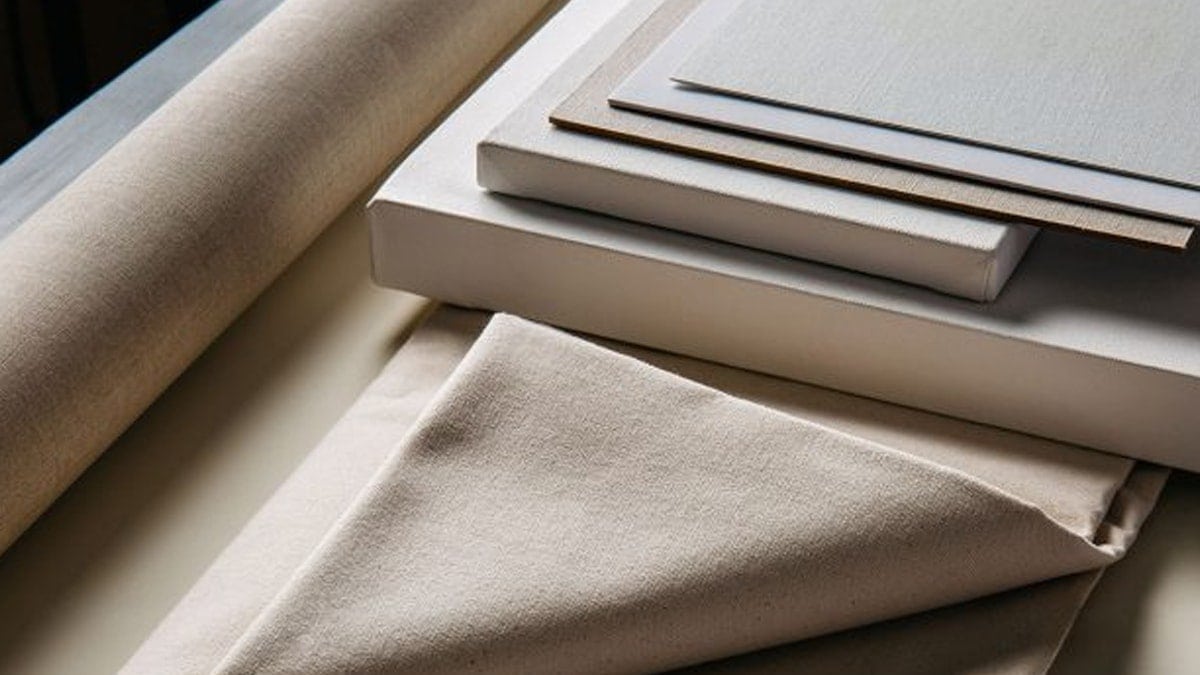
Choose canvas over wood or paper.
I’ll tell you why.
#1 It’s receptive to acrylic paints.
#2 It’s lightweight and easy to transport.
Canvas can be expensive but it’ll let you make a meticulously detailed painting.
Furthermore, there are four major types of canvas for acrylic painting:
- Stretched Canvas
- Canvas Panels
- Canvas Pads
- Canvas Rolls
I’ll leave it to you to choose.
4. Acrylic Painting Palette
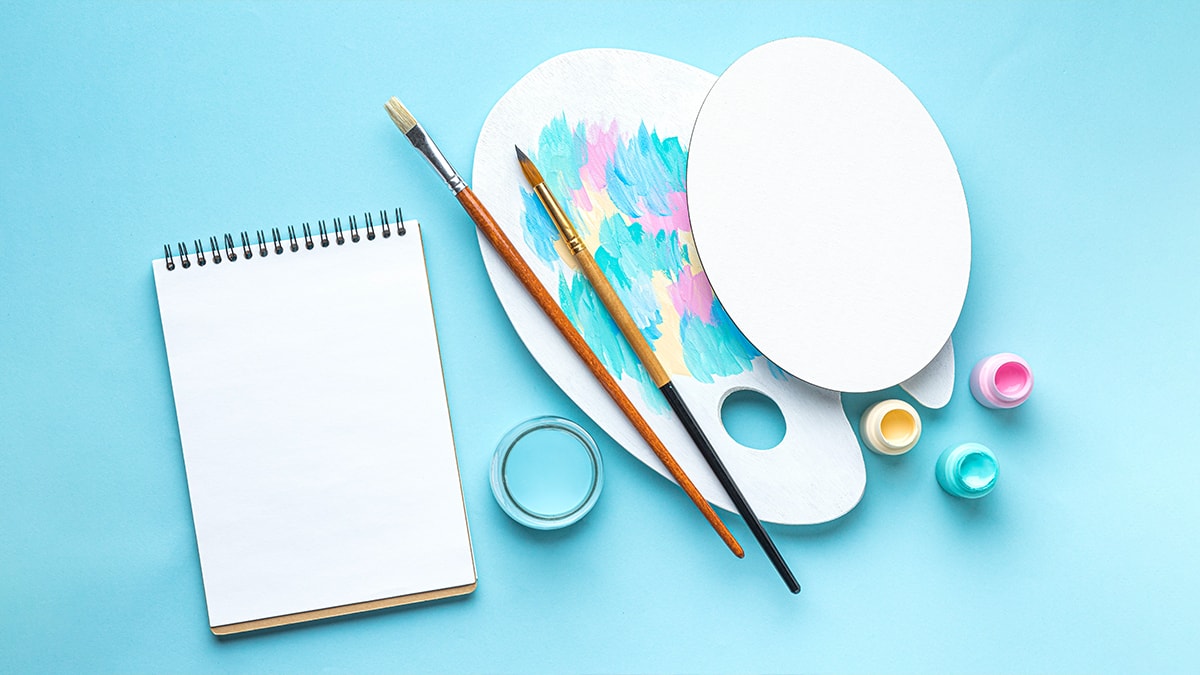
Three things to know about color palette before you start acrylic painting:
Your color palette should be easy to clean, have a flat surface, and have a large space for mixing.
Although they’re crucial factors to look for, you can still buy other types as per your comfort and technique.
(Read: Watercolor vs. Acrylic)
5. Easel

Most people make their first acrylic painting at home. And so will you. I believe.
Taking that into account, a floor-standing easel can be great since it prevents shoulder or back pain, and is easy to set up.
However, you’ll find different easels according to your preference.
Make sure you buy one that has multiple height settings, customizable tilt angle, and is easy to access.
6. Paper Towel

It won’t be a necessary item for the development of acrylic painting, but it’s good to have it handy.
Try to keep rag cotton next to you as it absorbs moisture quickly which helps you in cleaning bristles.
If you have kids or pets, you better have paper towels while painting since they can create a ruckus, and spill paints all over the floor.
7. Water Container

Some use Nutella, whereas some use fruit jam jars to fulfill their needs of cleaning brushes and thinning the paint.
However, some professionals choose ready-made water containers that serve this purpose.
As a beginner, you should repurpose home jars and allot the budget for the next painting when you’re familiar with the basics of acrylic painting.
8. Varnish & Its Brush

No matter how wonderful or terrible the painting comes out, you will have to preserve it.
And all you’ll need is varnish and its brush which gives the final touch, giving a layer of protection to it.
It’s up to you whether you want to pick matte or glossy, make sure you buy a reliable yet expensive one that’s known for giving an amazing glittery finish.
That’s all my friend.
You’ve bought almost everything that’ll succeed you in making a painting with acrylics.
Here’s the roadmap to it.
Also Read: Best Watercolor tips for beginners
C. How To Paint With Acrylics? Acrylic Painting Tips For Beginners
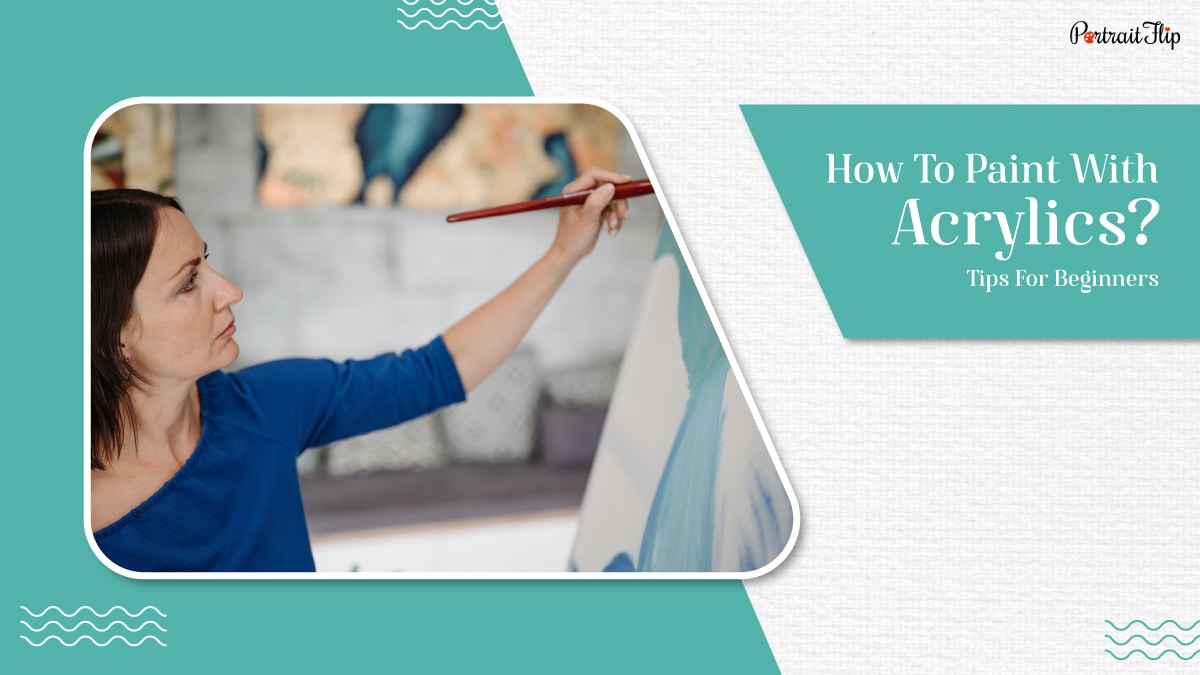
Here are the five basic steps to painting with acrylic.
1. Step 1

The first and foremost step is to find an appropriate spot in the home to place all your acrylic supplies.
Set your chosen easel and place your canvas on it.
Put down those colors you need on the palette, fill the water container, and put a rug handy.
The first step is all about having stuff organized since it gets dispersed during the process.
2. Step 2
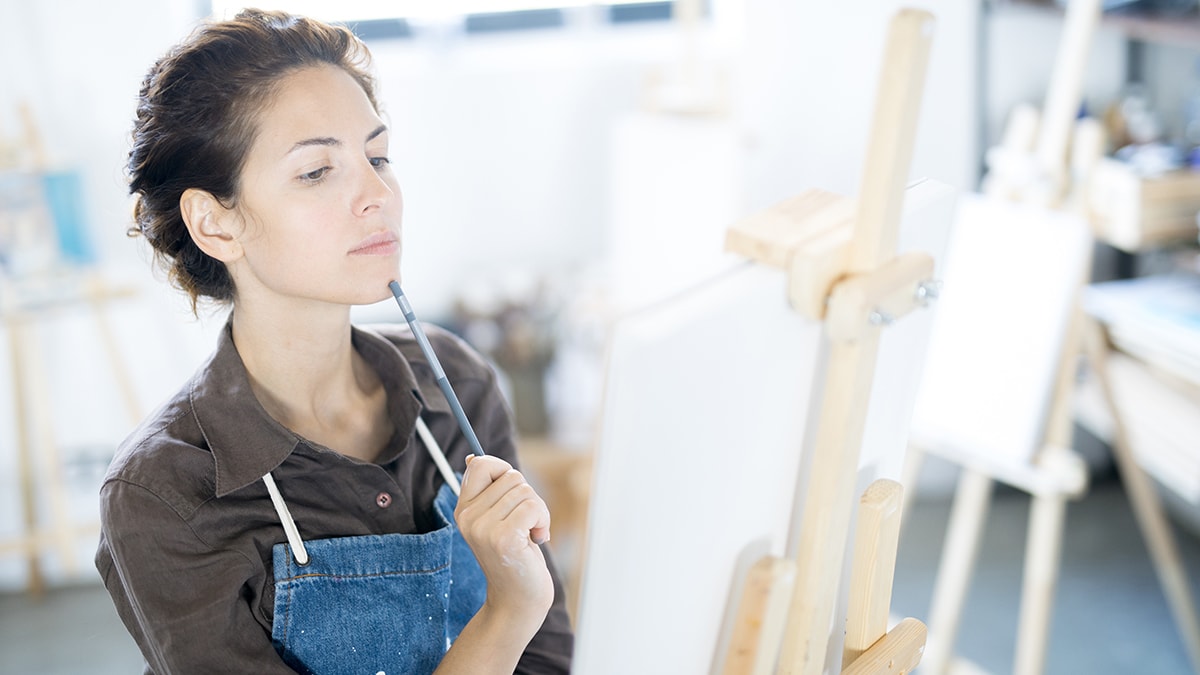
You will have to conceptualize before you take a brush in your hand.
Since you’ve figured out what you wanted to draw, sketch it beforehand to get a clear picture of how things will work out for you.
For instance, if you’ve decided to draw a landscape, it’ll be easier to sketch it on plain paper or canvas that you use for painting.
As a beginner, you should focus more on learning than speed or your craft. Because you will have to learn the process before you try out other painting styles and techniques or make advanced-level portraits with acrylics.
3. Step 3

Step 3 tells you to start painting but if you’re uncertain about the painting, try to stick with a couple of colors.
Pick colors of your choice, mainly primary ones, and squeeze them into the color palette.
We’ll recommend you use a small amount since colors might get dried out before actually being used.
Along with primary colors, use black and white that help you to produce different shades and textures.
4. Step 4

Use the flat brush to outline the subject of the painting.
Since we’re creating a landscape, begin by outlining the pyramid or diamond structure of the mountain.
Also, the other elements as well such as a lake, trees, or a shore—depending on your idea.
Once you’ve outlined the main elements, start using the color that you’ve put on the palette.
5. Step 5
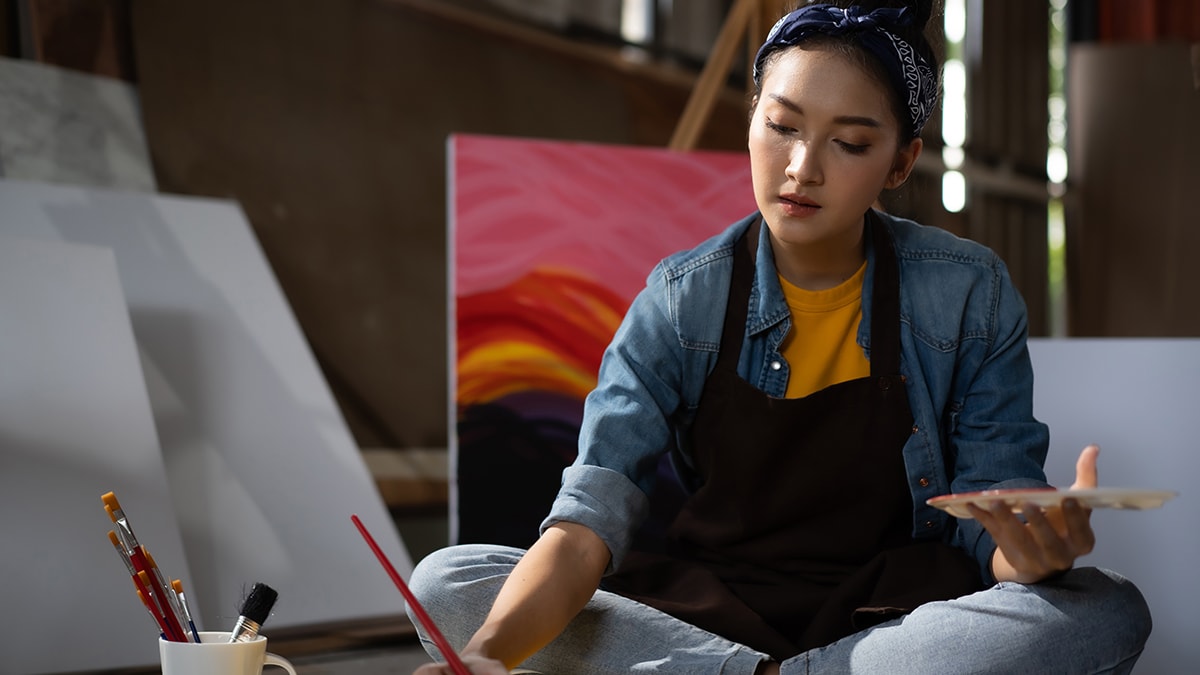
After outlining and coloring the major shapes of your painting, try using smaller brush strokes to add touches of detail.
Now grab fine-tipped brushes to add visual effects as they help in filling in details.
6. Step 6

This isn’t an important step in the process of acrylic painting.
However, if you’re proud of what you’ve made, and want to ensure it lasts, use varnish to preserve your painting.
It simply adds a glossy and shiny feel to your acrylic painting, preventing it from flaking and scratching.
And here you go.
You’ve just made a painting with acrylics.
Now let’s learn a few techniques to save some time and perfect your craft.
Suggested read: Tips on Water Color Paintings.
D. 5 Pro Tips To Level Up Your Acrylic Painting Skills

You will only master it if you know the right techniques. Importantly, when you practice them more often.
Here are some acrylic painting technique suggestions:
1. Make Use Of a Dry Brush

Initially, you would try diluted color, and a mildly wet brush to make an acrylic painting.
However, our experts suggest using a dry brush to create scratchy and textured strokes.
A painting needs textures to emphasize the subject, brush will do its work.
2. Follow Stippling

The technique commonly used in making acrylic landscape paintings is to form art from dots.
This way you’ll use dots to create an image that shows texture and a fascinating painting with a subtle color difference.
3. Use Palette Knife

Using a knife is the same as icing a cake or buttering a toast.
Both require skills and an artistic approach.
The detailed work requires supplies like palette knives to remove dry colors from the canvas.
4. Use Dabbing Technique

You’ll need a sponge or a rag to dab; to apply paint with light pressure to create depth in the painting.
Since you’re making landscapes, dabbing adds movement and is best used to illustrate greenery.
5. Add Details

Detailing is the last move an artist makes to add precision and captivating features to an acrylic painting.
Here all you need are brushes with small and fine bristles; especially, when you’re painting landscapes, you need careful attention to detail, and these types of brushes serve the purpose.
These are the 5 pro Acrylic Painting tips for beginners.
Let’s move to the final part, and learn how you can avoid mundane tasks and save your time.
E. Learn Basics To Maximise Your Productivity

An artist often gets frustrated when he sees himself working on tasks that barely contribute to results.
Great results require knowledge. And it’s imperative to have the basic knowledge to put in more time in actual work.
Here is what all you need to know:
1. How Do You Set Up An Acrylic Palette?

Make sure the palette is clean before you take it to use.
Decide which color you want and then squeeze them onto the palette.
It’s up to whether you want to put a small or large amount of paint onto the palette. Make sure you don’t over-squeeze them since acrylic paints dry quickly.
Space out the colors around the perimeter of the palette.
This is how you get to use the center of the palette for mixing different shades.
2. How Do You Mix Acrylic Paint To Get New Colours?
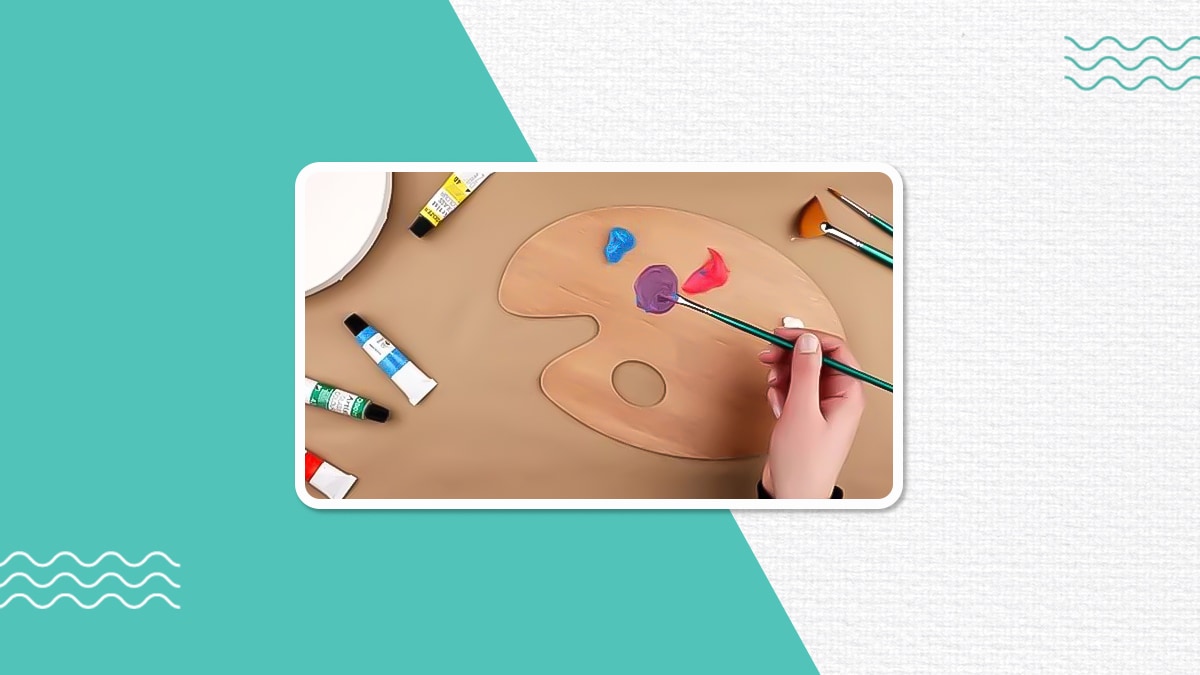
To fine-tune your color selection, pull 2 dabs of different colors to the center of your palette, and mix them with a knife or brush.
This will help you create rich hues to give your painting a personalized look.
If you want you can lighten colors without changing their opacity by mixing them with white paint.
Perhaps, many artists have multiple color palettes beside them to use various acrylic shades.
Since acrylic paints dry out quickly, work quickly on the mixing part.
(Also Read: 6 Oil Painting Tips To Hone Your Artistic Skills)
3. How Do You Keep Acrylic Paint From Drying Out?
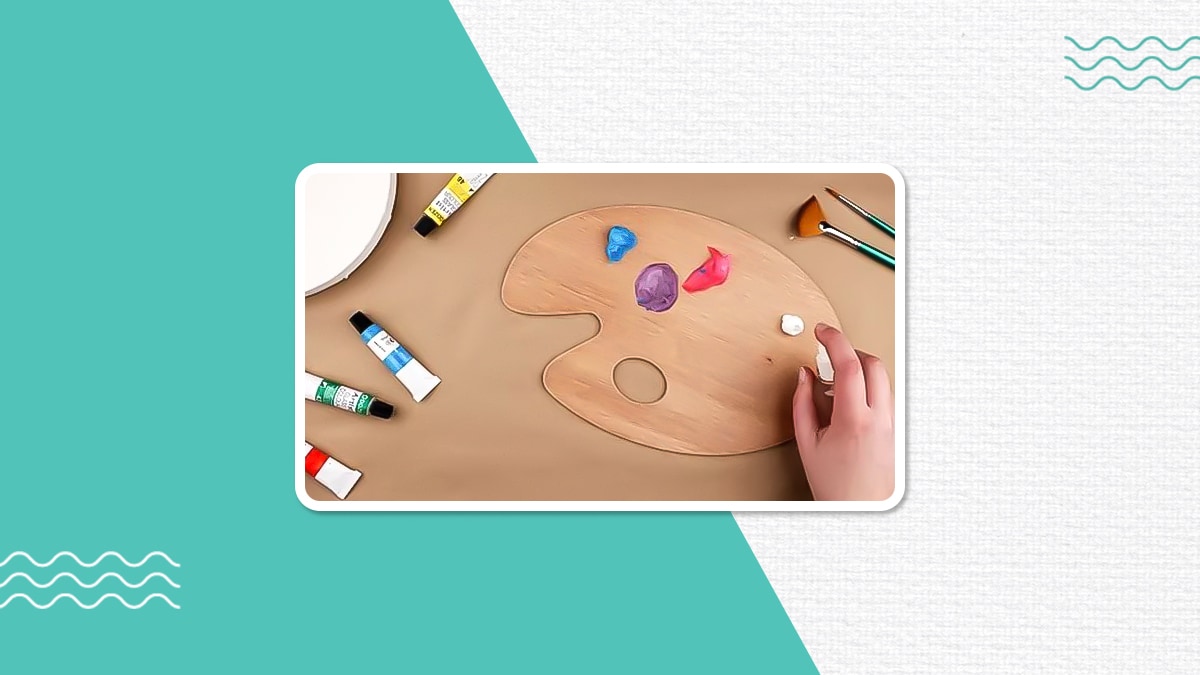
There are 2 easy ways to keep your acrylic paint from drying out.
- Mist your acrylics on the palette: Keep a small spray bottle handy to balance the water leaving the paint surface. Spritz the water over the paint whether it’s on the palette or canvas. You have to be careful when you spray acrylics on canvas supported by an easel since over-misting can lead to paints dripping down the palette.
- Use a stay-wet palette: Get yourself a stay-wet palette that offers an adequate amount of water to your acrylic paint, preventing it from drying out. It’s up to you whether you want an absorbent paper layer or greaseproof paper.
4. How Do You Thin Out Acrylic Paint?

You should know how to thin out acrylic paint before you make use of it.
And the best and simplest way to do it is by adding some water to it and decreasing its opacity.
Acrylics are generally thick in nature. Thinning out on your palette makes it transparent, giving appropriate texture to your painting.
Remember, when you’re diluting acrylic paint, you shouldn’t add more than about 20% water compared to the paint.
If you do so, the acrylic paint won’t stick to the surface, gradually peeling off once it’s dry.
You should be careful with the thinning-out process since good textured acrylic paint decides the quality of the painting.
5. How Do You Create Texture In Acrylic Paint?

For making a painting with acrylics, you should know this popular technique called splattering.
First of all, you dip a paintbrush into water and then coat the bristles with acrylic paint.
Next, you will hold it firmly to strike it right below the bristles with the other hand.
You will continue doing it till the paint flies off in thick clots and turns into thick chunks of colors.
Splattering is a great technique to use if you’re making an abstract art piece.
You know what would be the best idea for you? A acrylic portrait of your house enclosed in beautiful colors.
Hello readers,
Thank you for reading this blog till the end.
I hope I was able to share some of my wisdom in painting with acrylic colors with you.
If I did really help, I would love to know about it, in the comments section below.
Don’t hesitate to share this article with someone who needs these acrylic painting tips for beginners.
Please subscribe to our YouTube and follow us on Instagram.
Au Revoir!
Frequently Asked Questions
Acrylic paints, brushes, a canvas, a palette, an easel, a paper towel, a water container, and varnish and its brush, are some of the materials you need to create an acrylic painting.
Make use of a dry brush, follow stippling, use a palette knife, use the dabbing technique, and add details—these are some of the pro tips to level up your acrylic painting skills.
The best and simplest way to do it is by adding some water to it and decreasing its opacity.






I’m a 75 yr. old burnout hippie that delved in abstract painting back in those days, but now all of sudden I want to learn good ways of painting with acrylics. You got me going already, just can’t afford lessons on a fixed income. Got my easel and table set up with supplies and ready. Don’t know if wife likes that idea? Oh well.
Hi Gary,
I am so glad you want to get back to painting. Acrylics are simply the best medium to step back into the painting game. If you even have the bare minimum supplies from the blog here like paints, brushes, a rag, and a canvas, a beautiful painting of a bouquet of roses for the lovely Mrs. will go a long way. Youtube will be of great help. Always search for step-by-step tutorials.